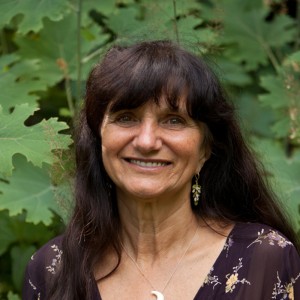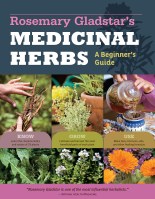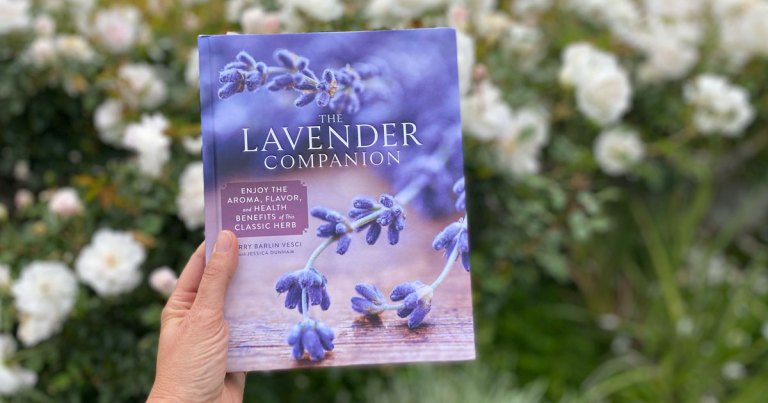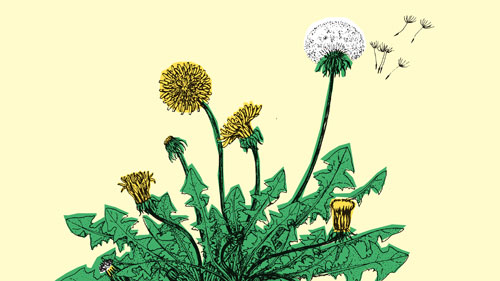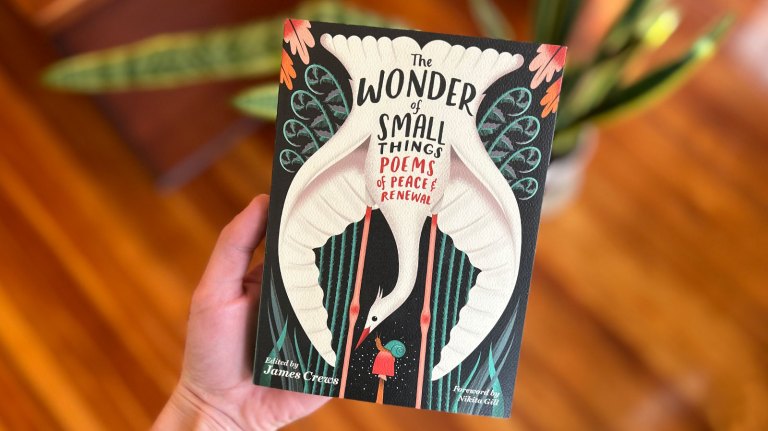Tradition Not Trademark: Fire Cider Goes to Court
While the herbal community awaits a judge’s decision on the legality of trademarking the herbal remedy known as fire cider, Rosemary Gladstar reflects on herbalism’s tradition of keeping medicine in the hands of the people.
Update: The verdict is in, and the herbal community has won!

From Rosemary Gladstar:
After a five year battle, “fire cider” is free from trademark restrictions and is officially considered a generic term, which means no one can own it — it belongs to all of us, and all are free to make and sell fire cider as they chose. What’s even more exciting is that this landmark victory sets a precedent and means that other herbal products and terms with a history of being commonly shared and community owned will be far less likely to be trademarked in the future.
Read Rosemary Gladstar’s original article about the trademark trial below.

The federal courthouse in Springfield, Massachusetts, is a large, modern building with an entire wall of glass facing the street. With its “cascading, concave roof . . . gracefully . . . framing the space in a delicate shell of steel and glass,” the courthouse is an imposing sight indeed. But even more impressive than this wall of steel and glass are the two ancient trees that the courthouse is built around. The edifice literally curves around a huge copper beech that looks like it’s been standing there for centuries, and the largest Tilia europaea, or linden tree, I’ve ever seen. It’s obvious that the architects took these trees into account when planning and building this courthouse. In reading about the building, I learned that the trees were “too powerful to ignore” and their preservation “was a key element in the design proposal that emerged” for the courthouse.

When several members of the herbal community found ourselves at the courthouse in the spring of 2019, those two ancient guardian trees and the wild garden beneath them, replete with healthy stands of black cohosh and maidenhair fern, helped make our four years of trial preparation and seven exhausting days in federal court bearable. Their beauty and strength rooted us deeply, giving us hope and courage.
So just how did we end up in that courthouse in Springfield? As beautiful and worthy of a visit as those trees were, being in Springfield wasn’t something any of us had planned on. The thought certainly wasn’t on my mind on that day a little over four decades ago when I made my first auspicious batch of an apple cider vinegar remedy as part of a winter health class. Like most herbal recipes, my formula wasn’t fully original but was based on several other old herbal recipes. I added my own touches: a few new herbs, a little something hot, a little honey for sweetness. When my students and I strained and tasted that first batch of herbal-infused vinegar several weeks later, a perfect merging of sweet, hot, spicy, sour, and pungent flavors exploded in our mouths. We knew we had created a winner and promptly named it “fire cider.” Fire cider is versatile and easy to make, and it’s an excellent cold and cough remedy as well as a tasty condiment. It became one of many of my favorite recipes, and I shared it openly and freely with students and other herbalists.
And that’s how fire cider began, in the herb school kitchen of the California School of Herbal Studies somewhere between 1979 and 1980. But who would have thought a simple recipe made from common kitchen ingredients would become as popular as it has — or as wildly controversial?
Fire cider spread out into the world rather slowly at first, but as I traveled and taught through the ensuing years and showed others how to make it, it developed a life of its own. People seemed to love this recipe, and if they didn’t love the original formula, they could adjust the ingredients until it was just perfect for them. Soon enough, as happens with most popular recipes, others were making their own versions of fire cider, and several people started small companies that began selling the remedy through farmers’ markets and co-ops, and websites. You could find the recipe in herb books, online courses, and videos, and herbalists often included it as part of their class curricula on herbs for winter health. Like so many other traditional herbal products in the marketplace, fire cider was community property, customizable to one’s own needs and tastes but belonging to everyone and available for anyone to make, sell, trade, and enjoy.
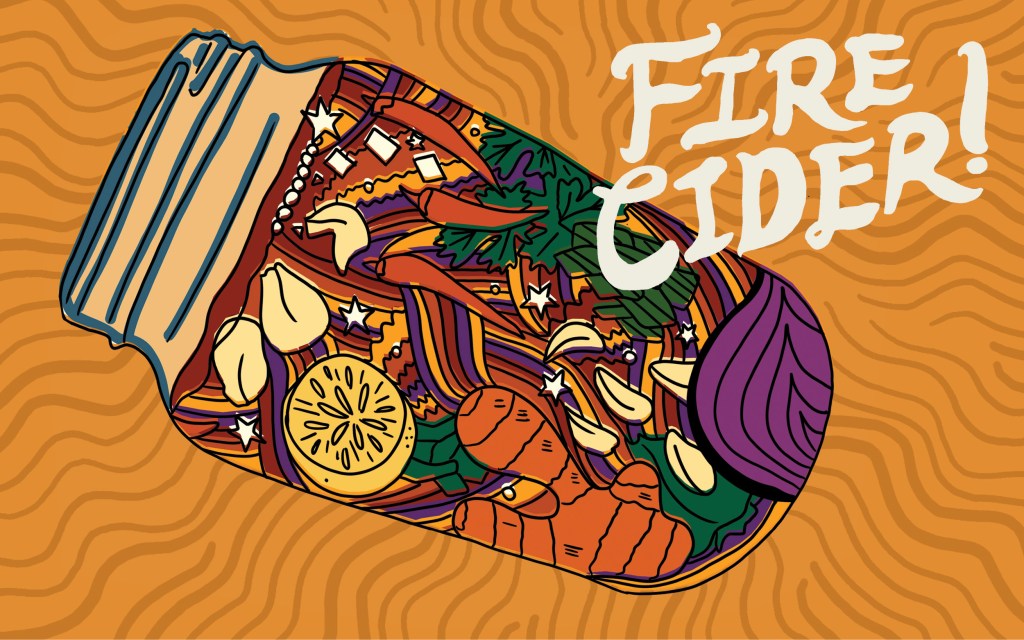
That’s how the story of fire cider should have continued. Unfortunately, that’s not how it went.
A little more than five years ago, a young upstart company saw a great opportunity and trademarked the fire cider product and the name. They then decided to take further legal action, filing a $100,000 lawsuit against Nicole Telkes, Kathi Langelier, and Mary Blue — three well-known community herbalists and farmers, avid activists, supporters of traditional herbalism, and makers and sellers of fire cider. The company claimed that these three women were damaging their business and had violated trademark laws.
Thankfully, the huge sum against Nicole, Kathi, and Mary was dismissed early on, but the trial over the trademark was still pending. The filing of the lawsuit shocked and frightened us. It had never occurred to me, or to most of us working within the plant medicine community, that a popular herbal remedy or a commonly used name could be trademarked. In our naivete, we thought trademark laws were in place to provide protection for people who had created their own original products or names from others who were trying to copy them. We didn’t realize that, in fact, a trademark could be obtained by anyone who grabbed the name and claimed ownership first. It was a wake-up call.
There has always existed a strong sense of sharing and cooperation among people who practice herbalism. People have readily shared recipes and information in classes, online, and through books and newsletters. After all, what good is a good remedy if it can’t be shared? In addition, many herbal remedies have been considered part of our herbal legacy and “community owned”; anyone was welcome to make and sell them if they chose. These are recipes — like those for Four Thieves Vinegar and the Queen of Hungary’s Water — that have been around for so long that ownership can no longer be traced, or — as with elderberry syrup, echinacea tincture, and fire cider — they are so popular they are considered generic. Hundreds of herbal formulas fall into this category.
The trademarking of fire cider changed everything. All traditional herbal formulas were suddenly vulnerable to trademarking. Shortly after fire cider was trademarked, a popular essential oil company trademarked Four Thieves Vinegar, which happens to be not decades but centuries old. What does that mean? After 500 years of being community owned and shared, it could only be sold under that name by one company. Herbalists would no longer be able to sell traditional herbal products using their original names — the names they are best known by. And customers who once had the opportunity to purchase these locally made products at farmers’ markets and local co-ops, through herbal mail order catalogs and online sites like Etsy, now have one choice. In the instances of Four Thieves Vinegar and fire cider, that choice is to purchase products made by companies that bought the trademarks and are not owned or run by herbalists. You don’t have to be an herbalist to make a good herbal product, but it does help.

Nicole, Mary, and Kathi decided that it wasn’t okay for companies to buy up the rights to popular herbal remedies that were already in existence and were considered community owned. They felt something needed to be done. As the spokeswomen for the movement that was forming around fire cider, they founded two organizations, Tradition not Trademark and Free Fire Cider, both dedicated to educating people about the issues surrounding the trademarking of traditional herbal products and the importance of keeping these herbal treasures as legacy herbal products — meaning they are available for everyone to make, use, and sell as they like. While the greater concern was for all traditional herbal products, the poster child was fire cider. Free Fire Cider called for a national boycott of the trademarked brand’s product and prompted people to make their own. Their petition to revoke the fire cider trademark gleaned over 9,000 signatures in the first few days. People cared. In the meantime, Mary and Nicole continued to sell their own brands of fire cider as they’d done for years in their local co-ops and farmers’ markets. This they did knowing it was a blatant trademark offense. Kathi rebranded her fire cider as Fire Tonic, but she was sued nonetheless. These women became known as the Fire Cider Three.

My role? As the creator of the original recipe and name, I was invested in getting this popular remedy back in circulation for the entire herbal community and I worked closely with Nicole, Mary, and Kathi on the behalf of fire cider. We became close friends and often consulted one another. When the lawsuit was filed, I wasn’t included simply because I hadn’t sold fire cider since the sale of my herb shop in the 1980s. But I was deeply invested.
Court itself was interesting and intense. None of us had ever experienced anything quite like it, nor do we plan to experience it again. We were all sworn in, examined, and cross-examined. We gave our testimonies, told our truth, and shared our stories. We were an awesome force, really. Witnesses who testified on behalf of fire cider spoke clearly and passionately about their work as herbalists and making and selling fire cider. Several had sales receipts dating to the early 1980s, confirming they had been selling it long before the trademark had gone into effect. Our expert key witnesses — Dr. Butters, a linguist, and Mark Blumenthal of the American Botanical Counsel (ABC) and editor of the prestigious journal HerbalGram — presented convincing arguments for fire cider being a generic name, free to be used by all. Our lawyers, Seth Coburn and Jim Goggin of Verrill Dana law firm in Maine, were simply amazing people. They really cared about the case and what it stood for. They understood what was at stake and were willing to devote endless hours at no pay to help preserve our traditional herbal recipes.

There were also those special moments between court sessions when we were together with members of the community who came to support us and Tradition Not Trademark during the trial. They brought lunches that were spread picnic-style in the courthouse pavilion so that we’d have healthy food. They cheered us on and helped defuse the anxiety that goes with being in court. And there were the guardian trees in the center of it all. Those trees were a bastion of strength for three young women who were on trial, like in the witch hunts of old, for having the audacity to stand up for their herbal traditions. Ballads will be written about them. In fact, there are a few already being sung (and some are included in the new fire cider book!). When we stood beneath those ancient guardian trees, grounding and receiving energy, they reminded us why we were even fighting this strange battle we found ourselves in and helped us draw strength from deep within the earth.
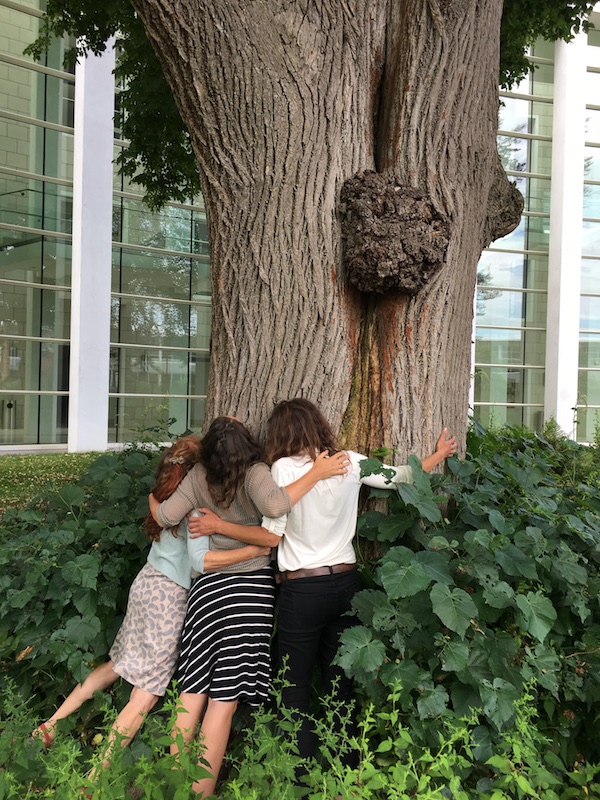
The story is still unfolding. Unlike in the movies where the judge steps out after a few tense moments and publicly announces the final verdict, in real life, reaching a decision is a long, meandering process. First there are the court proceedings, which can take several months, followed a few weeks later by a debriefing between lawyers and the judge. Several weeks after that, the lawyers present their closing arguments to the judge, and then the judge has several weeks to think and make a decision.
We’re all on the edge of our seats waiting. It was never our intention to go to court over this. We had hoped for a resolution through mediation in which the company that trademarked fire cider could continue to sell fire cider under their name but still allow other smaller companies to sell it as well. That way, everyone would be a winner and get to enjoy a piece of the good old apple pie (another generic name). If the case were to be determined simply on truth — the truth of who made fire cider first, the truth of who was selling it first, the truth of where it originated, and the truth that it has been a popular herbal remedy for more than four decades and is regarded as a traditional herbal legacy recipe — then the herbal community would certainly win. But trademark laws are a slippery slope, and even the savviest trademark lawyer is never sure how a case will turn out. No matter what the outcome, we’ve won simply by standing up for what we believed in, speaking our truth, and standing strong for our herbal traditions. After all, they are some of the oldest traditions on the planet, and they belong to all of us.
Like most of this battle, the book Fire Cider! has been a community effort and is our attempt to keep the story of fire cider alive and well. It was written to ensure that traditional herbal formulas, those recipes and remedies that have a long history of use, are kept free for all to make, use, and sell as they choose. It’s a lively collection of recipes that were contributed by more than 70 herbal enthusiasts, with energizing versions of fire cider ranging from Black Currant Fire Cider to Triple Goddess Vinegar, Fire Cider Dark Moonshine, and Bloody Mary’s Fire Cider. Colorful asides, including tribute songs and amusing anecdotes, capture the herbal community’s passionate desire to pass along the fire cider tradition.
So gather up the kids or the neighbors, a few kitchen herbs, and a bottle of apple cider vinegar and get chopping. It’s easy and fun. Remember when making your first or next bottle of fire cider that you are participating in the herbal healing arts, a tradition that goes back thousands of years. Welcome to the wonderful world of herbs! Have fun! Stay healthy!
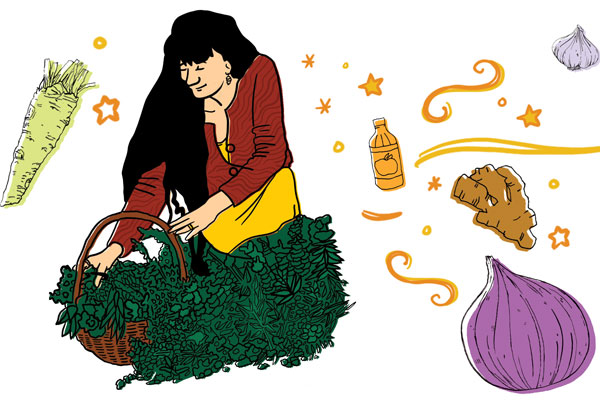
Fire Cider: Rosemary’s Recipe
Ingredients
- ½ cup grated fresh horseradish root
- ½ cup or more chopped onions
- ¼ cup or more chopped garlic
- ¼ cup or more grated ginger
- Cayenne pepper, fresh (chop it up) or dried (flaked or ground), to taste
- Apple cider vinegar (preferably raw and organic)
- Honey
Directions
Place the herbs in a half-gallon mason jar and add enough vinegar to cover them by 3 to 4 inches. Seal the jar with a tight-fitting lid. Place the jar in a warm spot and let sit for 3 to 4 weeks. Shake the jar every day to help in the maceration process.
After 3 to 4 weeks, strain out the herbs, reserving the liquid. Warm the honey (so that it will mix in well) and add it to the vinegar, to taste. “To taste” means your fire cider should be hot, spicy, and sweet. “A little bit of honey helps the medicine go down . . .” The honey also helps cool the heat, moistens, and balances all the fiery ingredients.
Bottle, label, and enjoy! Fire cider will keep for several months unrefrigerated if stored in a cool pantry. But it’s better to store it in the refrigerator if you have the room.
A small shot glass daily serves as an excellent tonic. Or take fire cider by teaspoons throughout the day if you feel a cold coming on. Take it more frequently, if necessary, to help your immune system do battle.
Excerpted From Fire Cider! © Rosemary Gladstar.

